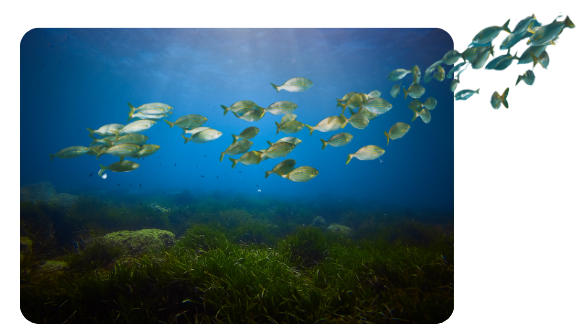
Dr Samantha Garrard
Marine Ecosystem Services Researcher
sga@pml.ac.uk | +44 (0)1752 633100 (switchboard)"Working within PML’s multidisciplinary team allows me to collaborate with internal and external partners to deliver policy-relevant science that supports the sustainable management and protection of our oceans for future generations. "
Dr Samantha Garrard is a senior interdisciplinary research scientist in the Marine Ecology and Society group based at Plymouth Marine Laboratory. Her research explores the impacts of human activities and climate change on marine biodiversity and ecosystem services, as well as identifying effective mitigation and adaptation strategies. Her interdisciplinary research integrates marine ecology and social science, encompassing risk assessments, ecosystem service assessments, public perception studies, stakeholder engagement, and policy analysis. She has contributed to projects in some of the world’s most dynamic marine environments, with fieldwork and collaborations spanning the Mediterranean, North Atlantic, South America, Southeast Asia, and the Caribbean.
She is actively engaged in science-policy dialogue, regularly contributing to workshops and high-level discussions, including with the Indian Ocean Rim Association and the UK’s Department for Environment, Food & Rural Affairs (Defra). She has also participated in sessions of the Intergovernmental Negotiating Committee developing a legally binding international treaty on plastic pollution, including in the marine environment, as well as the UK Treaty Dialogues and Multistakeholder Treaty Dialogues convened by the Ocean Plastics Leadership Network (OPLN).
Sam holds degrees in marine biology and aquatic resource management, and earned her PhD through the Open University while based at the Stazione Zoologica Anton Dohrn in Ischia, Italy. Her doctoral research focused on the effects of ocean acidification on plant-animal interactions in Posidonia oceanica seagrass systems, using natural CO₂ vents as a field laboratory. She has since worked as an ecologist and ecotoxicologist, and now specialises in interdisciplinary research, bridging environmental and social sciences to inform sustainable ocean management.
Key Projects
- Pacific Plastics: Science to Solutions. GCRF funded. 2020-2024 (https://www.pacificplasticssciencetosolutions.com/)
- North Atlantic Microplastic Centre (NAMC) Society and Regulation pillar. Funded by Agenda Vestlandet 2020–23.
- Risks and Solutions: Marine Plastics in Southeast Asia. UKRI funded. 2020-23
- The Economics of Marine Plastic Pollution: What are the Benefits of International Cooperation? ESRC funded. 2019 – 2022
- AquaPLAN-Aquatic Pollution from Light and Anthropogenic Noise: Management of Impacts on Biodiversity
Selected Publications
Garrard, S.L., Clark, J.R., Martin, N., Nelms, S.E., Botterell, Z.L.R., Cole, M., Coppock, R.L., Galloway, T.S., Green, D.S., Jones, M., Lindeque, P.K., Tillin, H.M., Beaumont, N.J., 2024. Identifying potential high-risk zones for land-derived plastic litter to marine megafauna and key habitats within the North Atlantic. Science of The Total Environment 922, 171282.
Garrard, S.L. 2023. Microplastics discovered in the body tissues of whales, dolphins and seals- sparking concern for human health too. The Conversation. 23 August 2023.
Garrard, S.L. 2023. Check your tyres: you might be adding unnecessary microplastics to the environment. The Conversation, 19 May 2023.
Garrard, S.L., Spicer, J.I., Thompson, R.C., 2022. Tyre particle exposure affects the health of two key estuarine invertebrates. Environmental Pollution 314, 120244
Garrard SL and Beaumont NJ. 2014. The effect of ocean acidification on carbon storage and sequestration in seagrass beds; a global and UK context. Marine Pollution Bulletin. 86(1-2): 138-146
Garrard SL, Gambi MC, Scipione MB, Patti FP, Lorenti M, Zupo V, Paterson DM and Buia MC. 2014. Indirect effects may buffer negative responses of seagrass invertebrate communities to ocean acidification. Journal of Experimental Marine Biology and Ecology, 461; 31-38.
Garrard SL, Hunter RC, Frommel AY, Lane AC, Phillips JC, Cooper R, Dineshram R, Cardini U, McCoy SJ, M. A, Rodrigues Alves BG, Annane S, de Orte MR, Kumar A, Aguirre-Martínez GV, Maneja RH, Basallote MD, Ape F, Torstensson A, Bjoerk MM. 2012. Biological impacts of ocean acidification: a postgraduate perspective on research priorities. Marine Biology 160 (8): 1789-1805
Unsworth RKF, Garrard SL, Salinas de Leon P, Sloman KA, Smith DJ, Bell JJ. 2009. Structuring of Indo-Pacific fish assemblages along the seagrass-mangrove continuum. Aquatic Biology 5: 85-95
Unsworth RKF, Salinas De Leon P, Garrard SL, Jompa J, Smith DJ, Bell JJ. 2008. High connectivity of Indo-Pacific seagrass fish assemblages with mangrove and coral reef habitats. Marine Ecology Progress Series 353: 213–244
Morasae, E.K., Botterell, Z.L.R., Andrews, S.H.V., Beaumont, N., Boisseaux, P., Chadwick, H., Cherrington, R., Cole, M., Coppock, R.L., Deakin, K., Duncan, E.M., Flor, D., Galloway, T.S., Garrard, S.L., Godley, B.J., Harley-Nyang, D., Lewis, C., Lindeque, P.K., McCutchion, P., Nolan, R., Osorio Baquero, A., Pinheiro, L.M., Savage, G., Storer, L., Thrift, E., Wilson, D.R., Woodhouse, C., Xavier, M., Yan, X., Nelms, S.E., 2024. Using systems mapping to understand the constraints and enablers of solutions to plastic pollution. J. of Env. Man. 2025, 371, 122994.
de Mora, L., Galli, G., Artioli, Y., Broszeit, S., Garrard, S.L., Baum, D., Weber, S., Blackford, J., 2024. Impacts of Climate Change on the Ascension Island Marine Protected Area and Its Ecosystem Services. Journal of Geophysical Research: Biogeosciences 129, e2023JG007395.
Douglas, J.; Niner, H.; Garrard, SL. Impacts of Marine Plastic Pollution on Seagrass Meadows and Ecosystem Services in Southeast Asia. J. Mar. Sci. Eng. 2024, 12, 2314.
